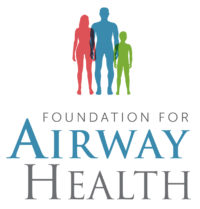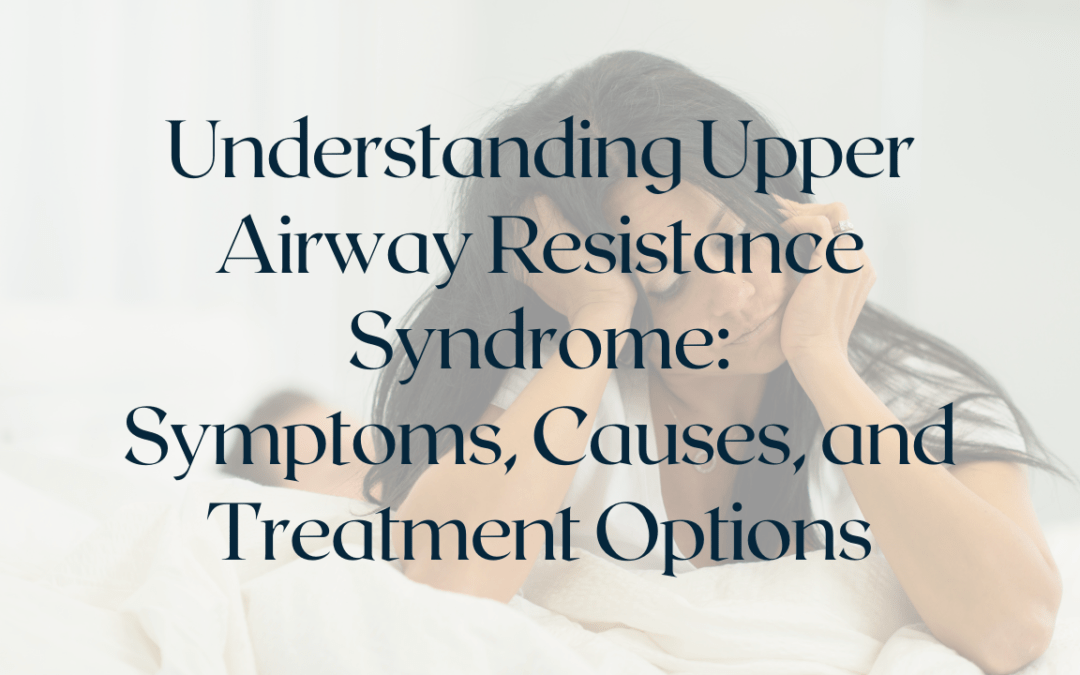Understanding Upper Airway Resistance Syndrome: Symptoms, Causes, and Treatment Options
Many of our clients have had sleep studies and have been told that they have Upper Airway Resistance Syndrome (UARS) but the conversation usually ends there. I’m not sure if it is because the practitioner doesn’t know where to go from there or if it just doesn’t seem like a big deal. Either way, it is a big deal and we see a lot of it here at Impact Myofunctional Therapy.
In The Dental Diet by Dr. Steven Lin, Dr. Lin describes this new classification (not discovered until 1993) as “sleep apnea’s little sister.”
Dr Steven Park, an ENT doctor from New York, describe the UARS patients that he sees:
“all UARS patients have some form of fatigue, almost all state that they are “light sleepers”, and most invariably they don’t like to sleep on their back. In some cases they actually can’t. Some people attribute their poor quality sleep to insomnia, stress, or working too much. Due to repetitive arousals at night, especially during the deeper levels of sleep, one is unable to get the required deep, restorative sleep that one needs to feel refreshed in the morning. In most cases the anatomic reason for this collapse is the tongue.”
In this piece, I’ll explore the symptoms, treatment options, and remedies for managing this condition. As someone deeply passionate about improving sleep quality and overall health, let’s unravel the mysteries surrounding UARS and shed light on effective solutions.
What is Upper Airway Resistance Syndrome?
Upper Airway Resistance Syndrome (UARS) is a sleep-related breathing disorder characterized by increased resistance to airflow in the upper airway during sleep. While similar to obstructive sleep apnea (OSA), UARS involves partial airway obstruction with the apneas (complete cessation of breathing) or the hypopneas (shallow breathing) very low or absent when compared to OSA. Individuals with UARS often experience repeated arousals from sleep due to the effort required to breathe against the resistance in the airway.
What are the Symptoms of Upper Airway Resistance Syndrome?
When it comes to identifying Upper Airway Resistance Syndrome, recognizing the symptoms is crucial. Unlike the more widely-known sleep apnea, UARS presents with subtler signs.
According to Dr. Steven Lin, the symptoms of UARS include:
- Digestive issues such as Irritable Bowel Syndrome, Crohns, chronic diarrhea, constipation, indigestion, acid reflux and bloating
- Cold feet or hands
- Low blood pressure
- Dizziness
- Lightheadedness
- Chronic runny or stuffy nose
- Sinus pain / headaches
- Migraines
- Tension headaches
- Stress
- Bruxism (teeth grinding)
- Clenching
- Depression
- Anxiety
- ADHD*
- Allergy shiners*
- Dry, cracked lips*
- Poor head posture*
- Bedwetting*
- Poor school performance*
- Constant tiredness*
- Open mouth resting posture*
* Indicates the most common symptoms in children
How is Upper Airway Resistance Syndrome (UARS) diagnosed?
Diagnosing Upper Airway Resistance Syndrome (UARS) typically involves a comprehensive evaluation by a healthcare professional, often a sleep specialist. While UARS shares similarities with other sleep-related breathing disorders like sleep apnea, it requires a distinct approach for accurate diagnosis. Here’s how UARS is commonly diagnosed:
Clinical Assessment: A thorough medical history and physical examination are conducted to assess symptoms related to sleep quality, daytime fatigue, snoring, and respiratory issues. It’s essential to provide detailed information about your sleep patterns and any associated symptoms.
Sleep Study (Polysomnography): Polysomnography is a diagnostic test conducted in a sleep laboratory or sometimes at home. During the study, various parameters are monitored while you sleep, including:
- Respiratory effort
- Airflow through the nose and mouth
- Oxygen levels in the blood
- Heart rate and rhythm
- Brain waves (to determine sleep stages)
- Body movements
Respiratory Effort-Related Arousals (RERAs): One of the hallmarks of UARS is the presence of frequent arousals during sleep, often associated with increased respiratory effort but without significant oxygen desaturation or complete airway obstruction. Polysomnography helps identify these respiratory effort-related arousals, which are characteristic of UARS.
Analysis of Sleep Architecture: The sleep study also provides information about sleep architecture, including the duration and distribution of different sleep stages. Individuals with UARS may exhibit disrupted sleep patterns, with frequent awakenings and reduced time spent in deep, restorative sleep stages.
Evaluation of Upper Airway Resistance: Additional tests, such as nasal airflow measurements or assessment of upper airway collapsibility, may be performed to evaluate the degree of upper airway resistance and identify potential contributing factors, such as nasal congestion or structural abnormalities.
Differential Diagnosis: It’s essential to differentiate UARS from other sleep-related breathing disorders, such as obstructive sleep apnea (OSA) and central sleep apnea (CSA), as treatment approaches may vary. Careful interpretation of sleep study findings and consideration of clinical symptoms are essential for an accurate diagnosis.
Overall, a comprehensive approach combining clinical assessment, sleep studies, and specialized tests is crucial for diagnosing Upper Airway Resistance Syndrome. Collaboration between healthcare professionals may be necessary to ensure an accurate diagnosis and effective management of this condition.
What Causes Upper Airway Restriction?
Several factors can contribute to upper airway restriction, including:
- Narrow airways
- Nasal congestion or obstruction
- Poor tongue posture
- Structural abnormalities in the mouth or throat
- Obesity or excess weight
Can Upper Airway Resistance Syndrome be Cured?
While there isn’t a straightforward “cure” for UARS, effective management strategies exist to alleviate its symptoms and improve overall quality of life. It’s essential to work closely with healthcare professionals to tailor a treatment plan that suits individual needs.
Is Upper Airway Resistance Syndrome the Same as Sleep Apnea?
Although both UARS and sleep apnea involve disturbances in breathing during sleep, they differ in various aspects. Unlike sleep apnea, where breathing pauses occur, UARS involves increased resistance to airflow without complete airway blockage. However, both conditions can significantly impact sleep quality and overall well-being.
What is the Best Treatment for Upper Airway Resistance?
The treatment approach for UARS typically involves a combination of lifestyle changes, medical interventions, and specialized therapies. Continuous Positive Airway Pressure (CPAP) therapy, oral appliance therapy (OAT), and myofunctional therapy are among the primary treatment modalities.
How Does Myofunctional Therapy Help with Upper Airway Resistance Syndrome?
Myofunctional therapy, like what we offer here at Impact Myofunctional Therapy, plays a crucial role in managing UARS. By targeting the muscles of the tongue, throat, and face, myofunctional therapy aims to:
- Improve tongue posture and function
- Strengthen weak or underdeveloped muscles
- Enhance breathing patterns during sleep
- Reduce airway resistance and promote better airflow
We see a lot of UARS in my practice. Most of our clients are suffering from poor sleep, lack of motivation, terrible digestion, weight gain, and chronic fight or flight. It makes sense to see these symptoms because
“UARS activates the sympathetic nervous system–the body’s survival mode–which releases adrenaline and causes a constant state of stress. The sympathetic nervous system also turns off digestion and sends the blood to the rest of the body, which explains the digestive symptoms in someone with UARS.” (Dr. Steven Lin)
I am also seeing a lot of stress and really high cortisol in my clients. Cortisol is a hormone that is produced by your adrenal glands. It regulates your energy throughout the day, your circadian rhythms (sleep and wake cycles), and also your stress response. When clients find us, they are at the end of the “desperation highway” and are stressed and feel like crap. It’s a vicious cycle. Poor sleep, blood sugar mismanagement, stress, poor digestion and a dysregulated nervous system are “all in bed together” working against any glimmer of health.
Believe it or not, there isn’t “one”correct way to get you back on track. Treating UARS comes from a multitude of ways. In my practice we work to stabilize the nervous system, learn sleep promotion strategies and breathing techniques, and make sure your blood sugar is balanced so you don’t have interrupted sleep.
Conclusion
Upper Airway Resistance Syndrome presents unique challenges, but with the right approach, individuals can effectively manage its symptoms and enjoy restful sleep once again. Whether through conventional treatments or natural remedies like myofunctional therapy, there are plenty of options available to support overall well-being and enhance quality of life.
If the information in this article resonates with you, we invite you to start your journey to wellness by booking your exam.
The most important message that I would like you to take from this article is:
“Quality sleep is the bedrock of your health. If you don’t sleep well and wake feeling rested, it is paramount to find the root cause. People wear poor sleep like it’s a badge of honor. Just because it’s the way you’ve always been doesn’t make it ok. Don’t ignore it. Just because it’s common. Doesn’t mean it’s normal.
Read The Ultimate Guide To Sleep Apnea & Sleep Disordered Breathing


Meet Carmen Woodland
I found this path of passion years ago as a dental hygienist. After a stint in graduate school to earn my M.B.A., I decided that I needed to pivot. My heart was no longer in scraping teeth, but making a much bigger impact on lives touched by myofunctional impairment.
My story is personal and close to home. My sweet granddaughter was passed back and forth amongst doctors and therapists for years trying to figure out her speech, breathing, sleep, chewing and swallowing issues. It wasn’t until I completed more training that I knew her problem was a significant tongue-tie. Bingo.
Fast forward to now. I’m a crusader. A warrior. A voice for those who can’t find theirs, or who don’t have one.
I left clinical hygiene practice to start Integrative Myofunctional Therapy. It has evolved from a way to make a living, into an obsession!
I see clients all over the world and provide innovative, virtual therapy in the remotest of places.
In addition, I also
- Teach other dental hygienists, speech therapists & dentists how to become myofunctional therapists through the Myofunctional Therapy Training Acadedmy.
- Coach dental offices on how to implement myofunctional screening into the daily practice
- Speak in various settings
I’m an airway provider for the Foundation of Airway Health, where I work diligently for the recognition, diagnosis, and treatment of airway-related disorders.
And last but not least, I’m a proud member of several professional associations that afford me the opportunity to learn so that I can help you. My professional memberships include:


